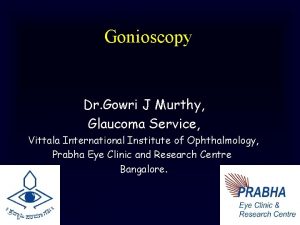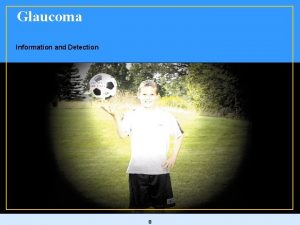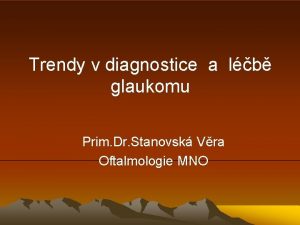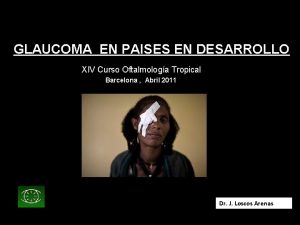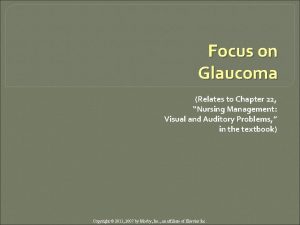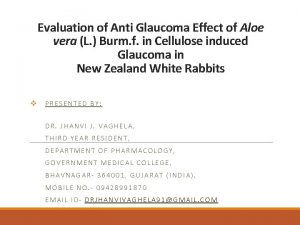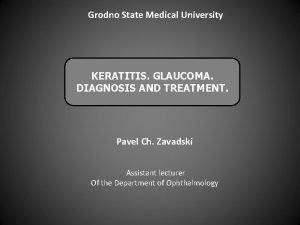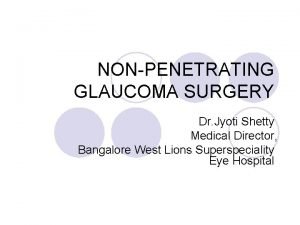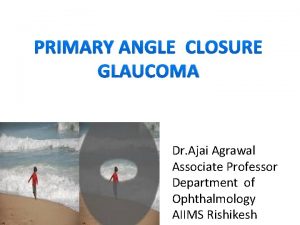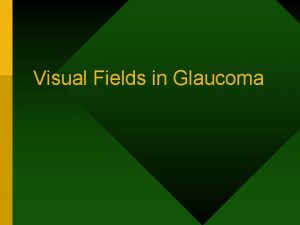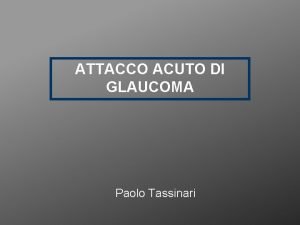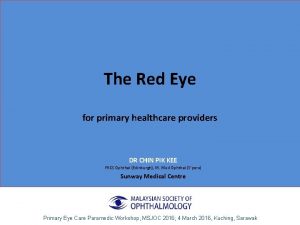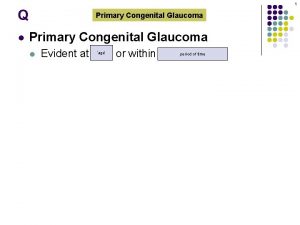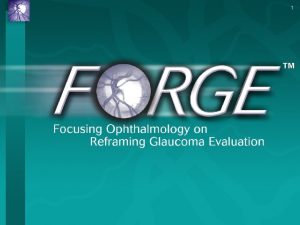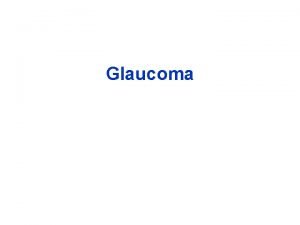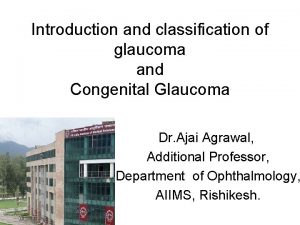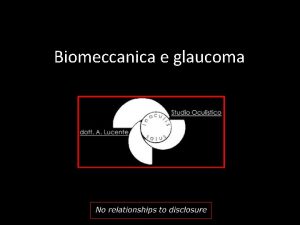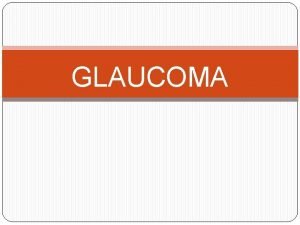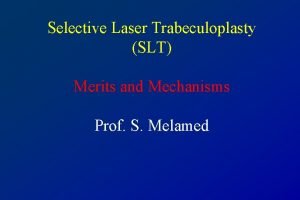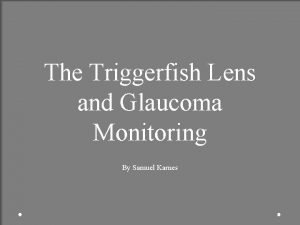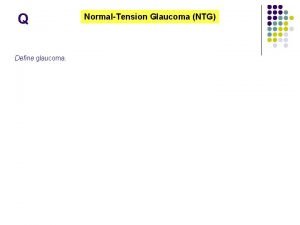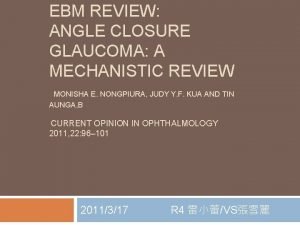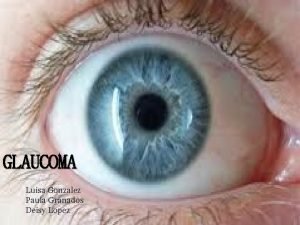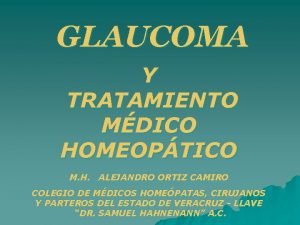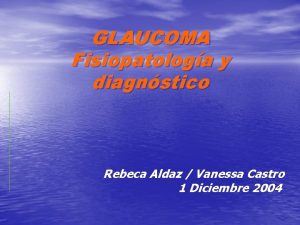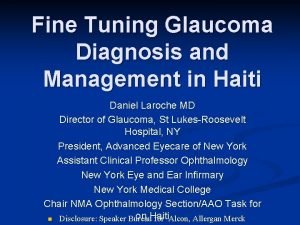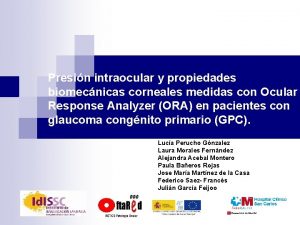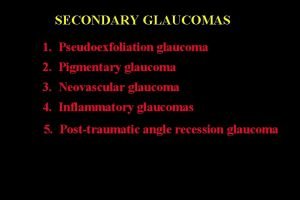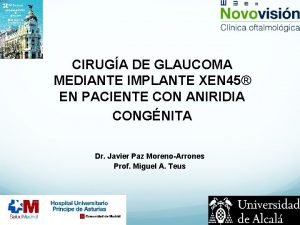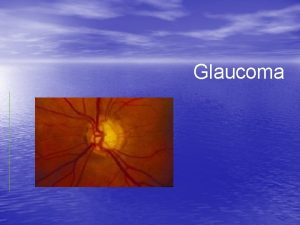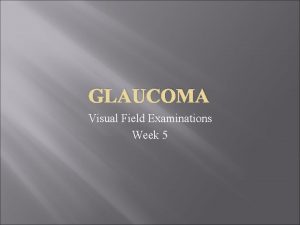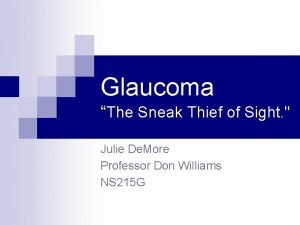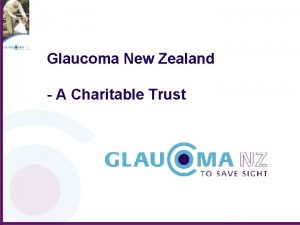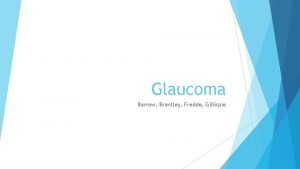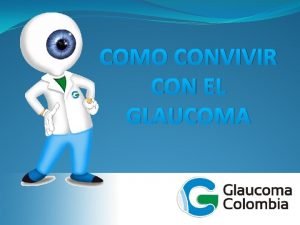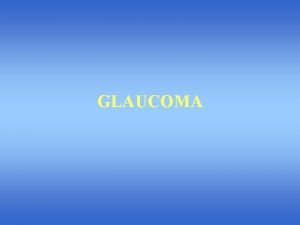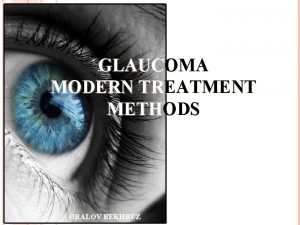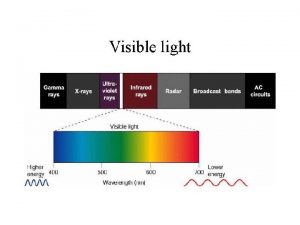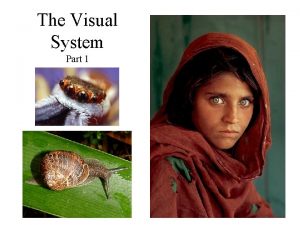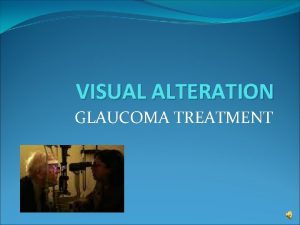Glaucoma The Silent Thief of Sight Prof S









































- Slides: 41

Glaucoma – The Silent Thief of Sight Prof. S. Melamed Director, The Sam Rothberg Glaucoma Center, Sheba Hospital, Tel Hashomer Tel Aviv University

Definition of Glaucoma Optic Nerve Disease with typical nerve damage and visual field loss ** Elevated IOP is a causative risk factor

Glaucoma and Blindness * Still reason # 2 for Blindness in the developed world !! * Reason # 1 for Blindness in most 3 rd world countries !!

Eye Anatomy • The optic nerve is a bundle of nerve fibers • It carries visual information from the retina to the brain

Fluid Circulation • The eye has an internal fluid circulation system • Fluid is produced at the base of the iris

Fluid Circulation • The fluid flows through the pupil to the front of the iris

Irido-Corneal Angle

CB-TM-SC Relationship Scleral Spur

Inner Wall of SC

“Self Cleaning Filter” Trabecular Cells Are: • Phagocytic • Secrete Proteo-Glycans • Are constantly moving • Retain Conductivity of TM • Remove blocking Particles

Normal Glaucoma

End- Stage Glaucoma

In Glaucoma Due to Obstruction/Malfunction of Drainage * IOP is Elevated * It causes damage to Optic Nerve and Visual Field

Normal Visual Field Healthy Optic Nerve Damaged Visual Field Sick Optic nerve Elevated IOP

In the Normal Population * IOP is 12 -20 mm Hg * 8% have elevated IOP – “OHT” * The OHT group has more chances for conversion to Glaucoma

Risk Factors for Conversion to Glaucoma *Family History of Glaucoma *Thin Corneas *Myopia *Black race *Vaso-occlusive diseases

What do we recommend * With risk factors OHT patients should be treated * All people above age of 40 should be checked regularly, every year, by an eye doctor * People with family history of glaucoma should be checked earlier

Why do we call Glaucoma “The Silent Thief of Sight”? ? * Because high IOP causes a gradual damage to nerve and visual field WITHOUT pain, discomfort or loss of Central Vision * The Damage is IRREVERSIBLE and can cause BLINDNESS * So, there are no “alarming signs” in most cases, and many people are diagnosed too late

Symptoms of Primary Open Angle Glaucoma • POAG develops gradually and painlessly and has no initial symptoms Vision is normal in the early stages

Symptoms of Primary Open Angle Glaucoma • If untreated, peripheral or side vision is slowly lost Tunnel vision

Symptoms of Primary Open Angle Glaucoma • Eventually, all vision may be lost

Glaucoma Tests: Slit Lamp & Gonioscopy • A special microscope called a slit lamp is used to examine the structures of the eye • A gonioscopy lens may be used to view the drainage angle

Glaucoma Tests: Ophthalmoscopy • Eye drops may be placed in the eyes to dilate the pupils • Special magnifying lenses are used to examine the retina and optic nerve for damage Normal Optic Nerve Suspicious Optic Nerve

Glaucoma Tests: Ophthalmoscopy • Advances are being made in digital imaging of the retina

Glaucoma Tests: Tonometry • Eye pressure is measured with an instrument called a tonometer • Three types that are commonly used are: – Goldmann (Perkins) – Non-contact (air puff)

Glaucoma Tests: Visual Field Test • Peripheral (side) vision is tested with a perimeter The patient responds to flashes of light in different locations

Recent Developments • Recent studies have found that patients with thin corneas have a greater risk of developing glaucoma • Measurement of corneal thickness using an instrument called a pachymeter will become increasingly important

Recent Developments • Laser technology can now be used to image the retina and optic nerve and measure nerve fiber layer thickness

End Stage Glaucoma – Severely damaged nerve with Tubular vision

So, How can we treat Glaucoma when Diagnosis is made? ? Treatment is aimed at lowering IOP to Normal Level * A variety of drugs (drops, pills) * Laser Treatment – Safe and Easy * Surgery – Filters, Valves, Shunts

Glaucoma Medications • • Medications are usually the first type of treatment used Eyedrops or pills are used to either decrease the fluid production or to increase the fluid drainage

What is new in Glaucoma Therapy? * New medications * New laser Treatments (SLT – The “Homeopatic Laser”) * New surgical methods – Drainage implants, Gold Shunts

SLT-New Laser Treatment Spot size comparison: ALT SLT 50µm SLTALT SLT 50 micron SPOT SIZE 400 micron 500 – 1, 000 m. W ENERGY OUTPUT 0. 8 – 1. 5 m. J 10 ms PULSE DURATION 3 ns 60, 000 m. J/cm 2 FLUENCE 600 m. J/cm 2 6 Latina MA, Tumbocon JA. Selective Laser Trabeculoplasty: The Evolution of Laser Treatment for Open Angle Glaucoma

SLT * The easiest and Safest Laser * Very efficient in lowering IOP * 5 minutes procedure in office * No pain, No complications * Now offered as a primary treatment before Drugs

When Laser and Medications fail or non-sufficient. . Glaucoma Surgery is recommended. . *Trabeculectomy *Drainage Devices *Gold Shunt

Gold Shunt

A Miniature Shunt

Gold Shunt Implantation

Gold Shunt

Early Detection and Treatment • Regular eye health examinations are important to detect glaucoma early so that treatment can be started and vision loss can be prevented

Thank You
 The way my mother speaks annotated higher
The way my mother speaks annotated higher Goldmann gonioscopy
Goldmann gonioscopy Open angle glaucoma risk factors
Open angle glaucoma risk factors Pex glaucoma
Pex glaucoma Goniopuntura
Goniopuntura Granulomatous vs non granulomatous
Granulomatous vs non granulomatous Preoperative nursing management of glaucoma
Preoperative nursing management of glaucoma Is aloe vera good for glaucoma
Is aloe vera good for glaucoma Congenital glaucoma
Congenital glaucoma Non penetrating glaucoma surgery
Non penetrating glaucoma surgery Schwalbe line trabecular meshwork
Schwalbe line trabecular meshwork Baring of blind spot in glaucoma
Baring of blind spot in glaucoma Iridoplastica
Iridoplastica Glaucoma continuum
Glaucoma continuum Open angle glaucoma symptoms
Open angle glaucoma symptoms Circumcorneal flush
Circumcorneal flush Congenital glaucoma triad
Congenital glaucoma triad Triggerfish glaucoma
Triggerfish glaucoma Pseudoexfoliation glaucoma
Pseudoexfoliation glaucoma Isnt rule
Isnt rule Laser iridotomy
Laser iridotomy Glaucoma management
Glaucoma management Capsulatomy
Capsulatomy Glaucoma phacomorphic
Glaucoma phacomorphic Bayoneting vessels glaucoma
Bayoneting vessels glaucoma Alt glaucoma
Alt glaucoma Triggerfish lens
Triggerfish lens Scheie stripe
Scheie stripe Primary angle closure glaucoma
Primary angle closure glaucoma Anillo neurorretiniano
Anillo neurorretiniano Springbank glaucoma
Springbank glaucoma Glaucoma angulo abierto vs cerrado
Glaucoma angulo abierto vs cerrado Dra vanessa castro
Dra vanessa castro Post operative nursing care plan for cataract
Post operative nursing care plan for cataract Indentation gonioscopy
Indentation gonioscopy Glaucoma congenito
Glaucoma congenito Pseudoexfoliation glaucoma
Pseudoexfoliation glaucoma Site:slidetodoc.com
Site:slidetodoc.com Piomes
Piomes Glasgow thang điểm
Glasgow thang điểm Thế nào là hệ số cao nhất
Thế nào là hệ số cao nhất Hệ hô hấp
Hệ hô hấp

